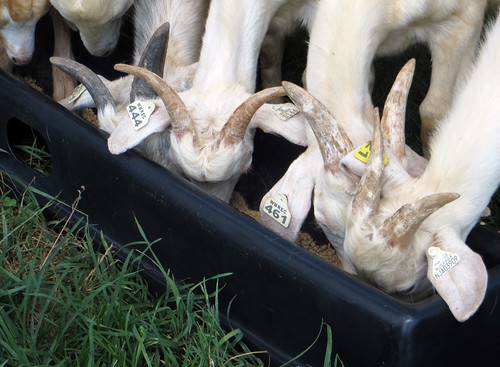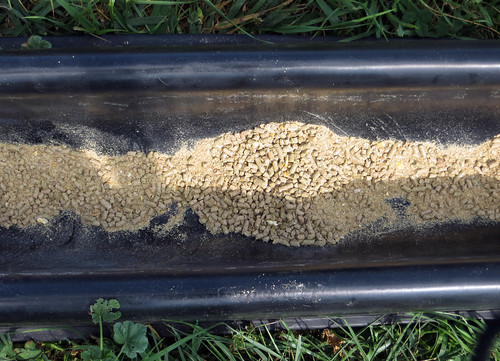Today, we began supplementing the bucks in the Western Maryland Pasture-Based Meat Goat Performance Test (and pasture group of the pen vs. pasture study) with soybean hulls.
Soybean hulls are a by-product of soybean processing. They consist primarily of the outer coating of the bean. They are a highly digestible source of fiber.
As with other by-product feeds, the nutritional composition of soy hulls varies. According to the Sheep Production Handbook (2002), soy hulls are 77% TDN, 12% CP, 0.57% Ca, and 0.17% P.
The reason for supplementation is to improve performance during the "growth-phase" of the test. Various studies have shown that soybean hulls are comparable to corn as an energy source for beef cattle that are grazing low and moderate quality forage.
From an economic standpoint, soybean hulls are a more economical source of energy than good quality hay (in Western Maryland) -- and easier to feed, with less wastage. However, they are a more expensive source of energy than corn or barley. These cost comparisons will be different in different parts of the country.
Once the bucks "learn" to eat the hulls, we will gradually increase the amount of supplementation to 0.75 lb. per head per day, approximately 1.5 percent of body weight. Today, 0.25 lb. per head was put out.
The bucks are also still "learning" to eat the Sunn Hemp and millet. So far, they have preferred to spend their time grazing the paddock of orchardgrass that is adjacent to the field of Sunn Hemp and millet.
Soybean hulls are a by-product of soybean processing. They consist primarily of the outer coating of the bean. They are a highly digestible source of fiber.
 |
| The hulls are being fed in Premier Porta Troughs™ |
As with other by-product feeds, the nutritional composition of soy hulls varies. According to the Sheep Production Handbook (2002), soy hulls are 77% TDN, 12% CP, 0.57% Ca, and 0.17% P.
The reason for supplementation is to improve performance during the "growth-phase" of the test. Various studies have shown that soybean hulls are comparable to corn as an energy source for beef cattle that are grazing low and moderate quality forage.
From an economic standpoint, soybean hulls are a more economical source of energy than good quality hay (in Western Maryland) -- and easier to feed, with less wastage. However, they are a more expensive source of energy than corn or barley. These cost comparisons will be different in different parts of the country.
 |
| Pelleting reduces the bulk density of the hulls. |
Once the bucks "learn" to eat the hulls, we will gradually increase the amount of supplementation to 0.75 lb. per head per day, approximately 1.5 percent of body weight. Today, 0.25 lb. per head was put out.
The bucks are also still "learning" to eat the Sunn Hemp and millet. So far, they have preferred to spend their time grazing the paddock of orchardgrass that is adjacent to the field of Sunn Hemp and millet.











